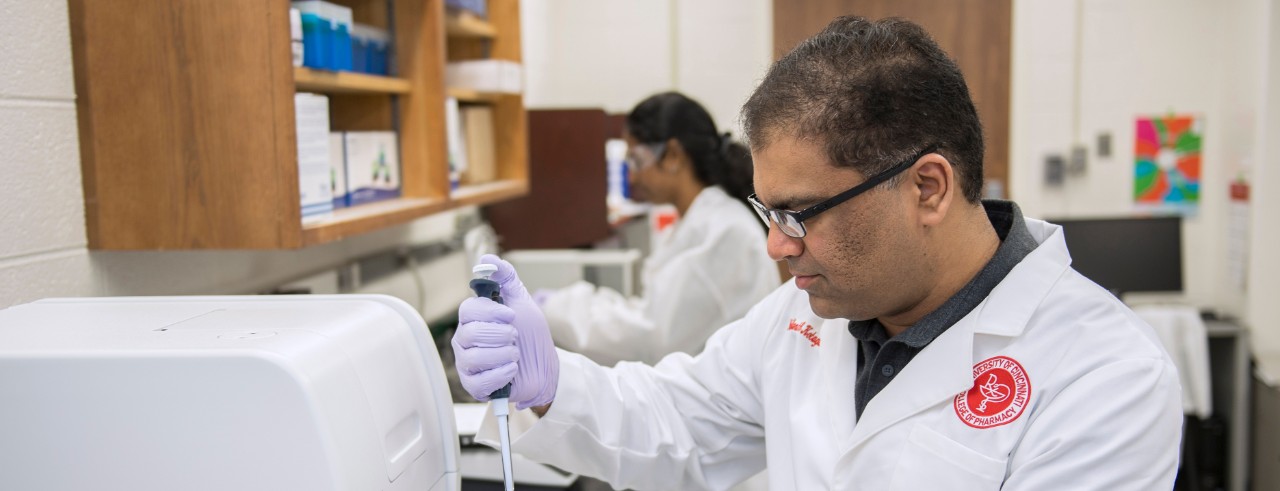
UC study focus: Faster, more accurate way to diagnose lung infections
UC researchers say that imaging has the potential to identify specific lung infections in real time
A federally funded study, led by University of Cincinnati researcher Nalinikanth Kotagiri, looks to develop a new imaging method that can identify certain types of lung infections — in real time — in order to speed up treatment for critically ill patients.

Nalinikanth Kotagiri is an associate professor of pharmaceutical sciences at the UC James L. Winkle College of Pharmacy. Photo/Colleen Kelley/UC Markting + Brand
Kotagiri, an associate professor of pharmaceutical sciences at the UC James L. Winkle College of Pharmacy, has been awarded a five-year $3 million, R01 grant from the National Heart, Lung, and Blood Institute (NHLBI) to develop and study the effectiveness of different kinds of injectable probes (metallic contrast agents) that would collect at the site of the infection and immediately light up under a nuclear imaging machine, known as a PET scan.
Currently, radiologists use chest X-rays to confirm the diagnosis of pneumonia and other infections in the lungs. An X-ray, however, cannot determine the specifics of the infection or whether the infection is bacterial, viral or fungal. A specific diagnosis can only be determined by a pathologist, after culturing a sample of lung tissue which is collected from an invasive procedure (called a bronchoscopy) and takes time, typically two to three days.
Our solution is to use imaging to identify what is causing the pneumatic episode within hours, to hasten a treatment plan.
Nalinikanth Kotagiri Associate professor of pharmaceutical sciences, UC James L. Winkle College of Pharmacy
Critically ill patients, however, such as those with infectious pneumonia and underlying conditions such as chronic obstructive pulmonary disease (COPD), might not have time to spare, says Kotagiri.
“Our solution is to use imaging to identify what is causing the pneumatic episode,” within hours, to hasten a treatment plan, he says.
An added benefit, he says, is that the contrast agent development process “doesn’t require elaborate processing or preparation time.” This is critical as development of contrast agents can be time-consuming and complicated. A simple and fast process is expected to reduce preparation time in a clinical laboratory and potentially enable adoption of the technology in a clinical setting.
With this study, in animal models, Kotagiri and colleagues will only be looking at bacterial and viral pneumonias in conjunction with COPD, but the imaging approach has the potential to apply to other types of infections such as fungal infections or conditions such as cystic fibrosis.
Imaging the patient after treatment, Kotagiri says, could also identify whether the patient is responding to medications such as antibiotics. Imaging could also potentially aid in determining the right antibiotics to use, targeting the pathogens that were identified.
The collaborators on this project include experts in COPD and lung diseases: Francis McCormack, MD, a pulmonologist, and Michael Borchers, PhD, at the University of Cincinnati. Changchun Xie, PhD, at the University of Cincinnati is the team’s biostatistician, and Suzanne Lapi, PhD, at the University of Alabama-Birmingham will provide the radiochemistry expertise to optimize contrast agent development.
Featured image at top of Nalinikanth Kotagiri/Colleen KelleyUC Marketing + Brand
Impact Lives Here
The University of Cincinnati is leading public urban universities into a new era of innovation and impact. Our faculty, staff and students are saving lives, changing outcomes and bending the future in our city's direction. Next Lives Here.
Related Stories
Study finds police officers face higher long-term health risks
January 2, 2026
J.C. Barnes, a University of Cincinnati professor, is interviewed by Spectrum News about new research showing that the physical and psychological demands of law enforcement can contribute to earlier deaths.
UC College of Nursing Professor honored with AANA education excellence award
December 23, 2025
Susan Newell, assistant professor in the UC College of Nursing, is being recognized by the American Association of Nurse Anesthesiology (AANA) as one of three top educational administrators and instructors. She will receive the Clinical Instructor of the Year Award during AANA's top educator event 2026 EDGE Conference, February 4-7 in Louisville, Kentucky.
Challenges for veterans in the workforce
December 22, 2025
A new research review examines how veterans and their families impact the economy.
